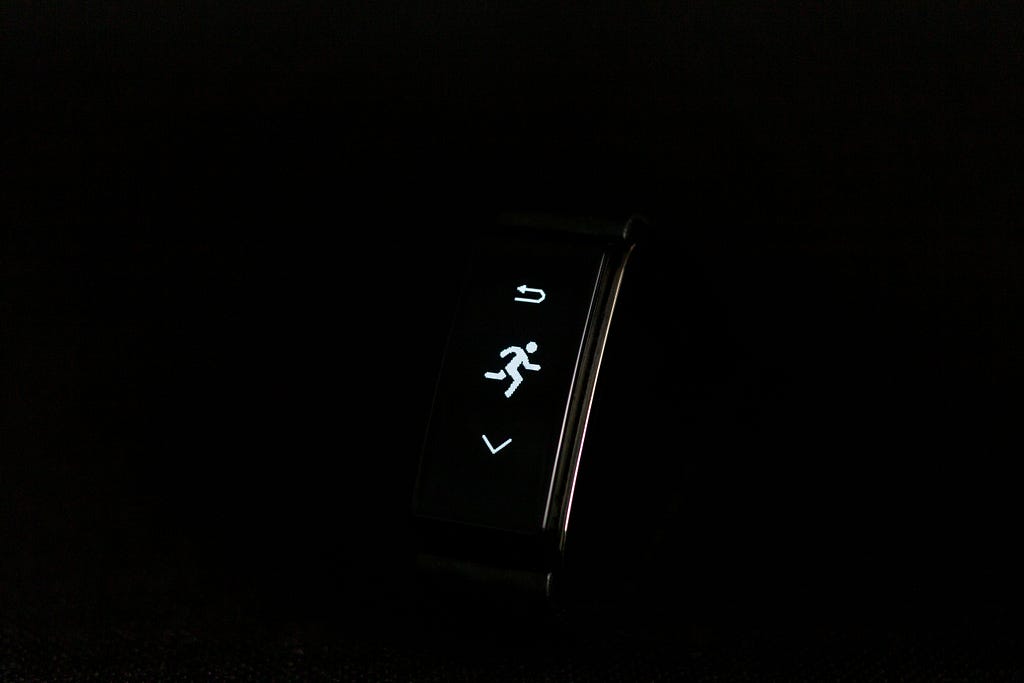Latest news about Bitcoin and all cryptocurrencies. Your daily crypto news habit.
This is Part 3 in an ongoing series where I go in-depth on how I successfully hack and improve my health through technology and science while having Fibromyalgia.
Read Part 1 and Part 2 first if you want the full story.
You intimately know what every vibration pattern and audible notification on your smartphone means. Long three-patterned vibration for a phone call, double-short for a text, BLOOP-BLEEP for an email, BEEP-BLOOP for a Facebook message. You recognize every notification it produces instantly, and you respond accordingly.
But how well do you know your the evolutionary notification system our bodies have developed? Can you even recognize the differences between them?
“Hey moron, body here. Pay attention to me!”
That dull, aching pain in your neck? Yeah, it’s from slouching again and being hunched over your laptop at work for 4 hours, Pam. Way to go. Now we all hurt.
That upset stomach after lunch that left your office bathroom’s paint peeling off the walls? Again, hello??? You had too much sodium again, Brett, and didn’t include enough carbs in your meal. Your coworkers are so grateful for you today.
That morning malaise with aching legs and a dull headache? Shocker, Ian: you went to bed too late two nights ago, ate too late last night, and didn’t sleep in the proper position — again. Way to ignore my signals and binge on The Marvelous Mrs Maisel (though, OK, it’s pretty hilarious). Jerk.
It’s a sad state of affairs when we understand our phone’s notification systems better than our own body’s. After all, we can’t upgrade these meat socks every year (. . . yet). So unlike our iPhones, we’re stuck with the ones we have.
Your Body’s Four Notification Types
Your body has essentially 4 signals that you need to begin listening to and deciphering in order to understand what it needs and wants:
- Pain
- Resistance
- Fatigue
- Mental Clarity
The best way to do this is by practicing the mental exercise of what I call signaling.
In order to know the difference between a real alarm and a simple notification (e.g., your alarm clock for work vs a new tweet from Elon Musk (just stop following him already)), you need to start taking time to listen and log what you observe. (No, this is not a diary. I don’t particularly care about your dear diary entries. This is about collecting data and developing the habit of an essential mental exercise. Though journaling is a fantastic habit that you should start if you don’t already.)
Get a small notebook that’s easy to carry around with you, download Evernote or use whatever app you prefer. If you’re logging your meals like you should be (I use MyFitnessPal religiously and have for 4 years. Every day.), then you can add a note in every meal while you log your food. Regardless, use a time, such as eating, when you typically have a break and can use the time for good. Put away social media, YouTube, and other completely useless and life-wasting apps, and practice listening and writing down the signals you are experiencing. You can use the traditional 1–10 scale (1 being least and 10 being most) or describe it with a tag system like I use (see below) — whichever way you prefer.
The key here is not so much the data (as we’ll learn how to track that later in a more advanced fashion through some cool new systems I’m developing) but the mental exercise of learning to feel and notice your body’s notifications.

1. Pain
There’s good news and bad news about your pain. The good news: it’s your body’s primary notification method (think of it like your phone’s vibration pattern) that something is wrong. The bad news: it’s the suckiest notification system ever.
So when you take your signaling break (preferably while eating), here are the questions you should ask yourself:
Where does it hurt?
- Picture your body going through an MRI or CT-Scan. Start at the top of your head and mentally scan your way down to your toes. Pay attention to every part. Your head, eyes, ears, mouth, jaw, neck, shoulders, etc.
- As you cover each area, stop and focus on it. Does it hurt? Is there pain here?
- When you reach an area that is tense or painful, focus on letting your muscles relax. Breathe in deeply and let them fall. You’ll be amazed at how much this simple little exercise reveals muscle areas that you unconsciously keep tight due to stress or bad posture.
What kind of pain is it?
- Stabbing (e.g., someone has a needle or knife and is repeatedly stabbing you in a small, precise spot. Over. And over. And over.)
- Aching (e.g., a low, throbbing, broad surface area similar to sore muscles after working out)
- Burning (e.g., a cross between nerve shooting pains and broad aches combined with the sensation of being near a fire)
- Flashing (e.g., that weird chronic pain that feels like your pain points are a string of flashing Christmas lights that turn on and off for no apparent reason)
How long has it been like this?
- A few minutes
- An hour
- All day
- My entire life (probably being a little dramatic, here. Reel it in, Anne.)
Start doing this at lunch EVERY SINGLE DAY. I’ve done this for 6 years. By doing it over and over and over again, you start noticing the different kinds of pain notifications your body gives without having to stop and listen for them. It becomes second nature, just like the sound of a new Facebook message. And with this skill, you’ll be able to start building fortitude in knowing when to push through and when to back off (see Part 2 to understand what fortitude is and how to use it).

2. Resistance
In addition to pain, your body also has a notification called resistance: that heavy, gravity-pulling malaise you feel when you attempt a new or difficult activity.
For example (this only applies to people who suffer from chronic conditions. Otherwise, you’ll think I’m crazy):
That moment of the day has come: the dreaded shower. You’re in pain, yes, but it’s not as bad today. You’re starting to pick up a whiff of overripe fruit, so you realize you should probably take a shower. You’re tired, yes, but you got a nap in and you have some energy. You look over towards the bathroom and you suddenly feel this sensation of a heavy weight throughout your body. Gravity is pulling you harder and the air seems thicker as you begin walking towards the bathroom. You could swear you just gained 50 lbs or the Earth suddenly tripled in size.
Or
You’ve been sitting on the couch binge-watching (or binge-reading if you’re a book nerd!) for 3 hours. You haven’t moved. Standing up would be a Herculean feat of physical triumph. The bathroom is so . . . far . . . away.
This is resistance. It’s not pain, it’s not fatigue, it’s friction.
It’s your mind resisting against expending energy on something it’s telling you isn’t crucial for survival.
When you are in perpetual fight or flight mode, even the smallest things can bring formidable resistance. And resistance is incredibly difficult to overcome.
Pay attention to this whenever it happens. Write it down in the same journal or app. Here are some questions to ask yourself:
What activity or action is causing resistance?
What happens when I push through and do it anyways?
Resistance is the most closely linked signal with developing fortitude. Fortitude is the ability to perform actions through resistance, because you know your body well enough to see when resistance should be pushed back against and when it should be heeded. We’ll talk about this later. For now, just start tracking it.

3. Fatigue
There are two tones for the fatigue notification.
First, you have the ordinary fatigue when you don’t sleep well, had too much to eat, are being lazy, haven’t exercised or just are being a fat ass. This is a milder notification, like the short little beep of an incoming email.
The second is much more severe. This is that all-encompassing malaise that feels like jet lag or a hangover. It envelops you and doesn’t depart. This is that obnoxious alarm clock sounding that keeps repeating every time you hit snooze until you want to chuck it across the room . . . if you had the energy to do so, of course.
But the sneaky trick with fatigue is that the more you rest, the worse it gets. Sure, your body is telling you you’re tired, but if you have a chronic condition, guess what: you’re not. It feels like you are, but you’re well aware that you can’t possibly need 24 hours of sleep. You don’t really have to rest all day. (We’ll get into how to hack your sleep for maximum optimization later. You could very well be exhausted for good reason.)
We’ll get into how to know the difference between needing rest and ignoring fatigue. For now, start paying attention to your fatigue levels. Ask:
How tired am I right now?
Am I more or less tired after waking up or taking a nap?
Did I do a physical activity that increased my fatigue?

4. Mental Fog
Your body also has physical notifications that affect your brain and your capacity to focus, think critically, and problem solve. Again, this varies in severity and cause, with differing notification signals for each.
The first is a lack of clarity, such as when you can’t focus or problem solve. It’s what happens after studying for a long period of time, working on a difficult coding challenge or being at a social gathering for hours. You just can’t bring your brain to think clearly. You’re working through a haze.
With Fibromyalgia, a second kind of mental fog is far worse. It’s referred to colloquially as Fibro Fog. It’s that mental state you have when you come down with the dreaded flu. It takes so much effort to focus on even the smallest of tasks. It’s completely debilitating, and for me, it’s my biggest struggle.
So start listening and paying attention to this state.
When did it start? What was I doing?
How severe is it?
Again, by hearing this signal, you’ll begin to start noticing degrees of it. Every signal has varying degrees of intensity, just like your phone notifications have different volume and vibration levels. When you’re ill, it’s easy to just throw it all to a 10 and complain on Facebook (STOP WHINING ON FACEBOOK GROUPS! GROUP WHINING IS CONTAGIOUS! IT’S A PLAGUE). But that’s like playing every measure of a song at fortissimo. It’s obnoxious and no one wants to hear it!
So start noticing the subtleties of the notifications, including mental fog. Is this really as bad as earlier this morning? Is it better than yesterday.

Let’s recap.
Set aside 10 minutes at lunch to listen to and decipher your body’s 4 notification types:
- PainWhere is it?What kind is it?How long have I had it?
- ResistanceWhat activity or action is causing resistance?What happens when I push through and do it anyways?
- FatigueHow tired am I right now?Am I more or less tired after waking up or taking a nap?Did I do a physical activity that increased my fatigue?
- Mental FogWhen did it start? What was I doing?How severe is it?
I promise you, after doing this over and over and over again, you’ll begin to understand not only what your body is telling you, but you’ll also be prepared to begin hacking your health to determine why it’s happening in the first place.
Eventually, you won’t even need to write it down anymore. Just like your smartphone’s notifications, your brain immediately recognizes the pattern and associates it with the information it represents. You instantly know the difference between a text, a WhatsApp message, an email, and a phone call.
All of this will become second nature and you’ll welcome every notification (within the normal range, of course) as information that guides you to a series of habits and responses you’ve developed to maintain and improve your health.
Have questions on signaling or how I specifically track things? Ask in the comments!
What’s your signaling story? What have you learned by listening to your body’s notification system? Share and comment!
Stop dismissing your body’s notifications. was originally published in Hacker Noon on Medium, where people are continuing the conversation by highlighting and responding to this story.
Disclaimer
The views and opinions expressed in this article are solely those of the authors and do not reflect the views of Bitcoin Insider. Every investment and trading move involves risk - this is especially true for cryptocurrencies given their volatility. We strongly advise our readers to conduct their own research when making a decision.
